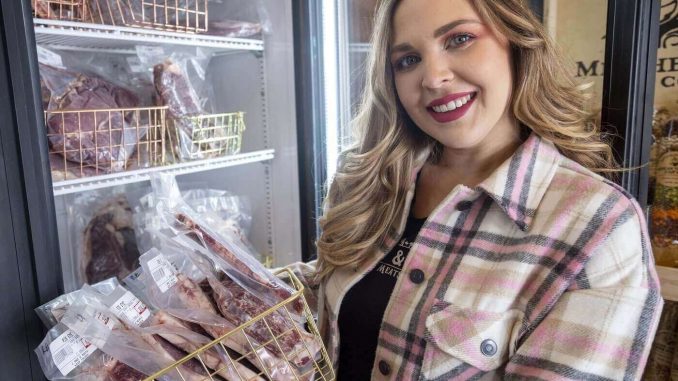
By Calvi Leon, Local Journalism Initiative London Free Press
Emma and Josh Butler, who raise cattle near Chatham, ditched the middleman years ago. Now, their farm-to-table business is booming amid the pandemic with beef sales up four-fold in only one year.
“When we started to put the numbers on paper and really look at this thing, it’s just astronomical,” Emma Butler said of the couple’s spike in sales from 2020 to 2021.
Full-time farmers and parents, the Butlers own J&E Meats Inc. in Croton. They raise cattle on their more than 1,000 acres and sell not the usual way, but directly to customers online and through a store on their farm.
The freezer-sale approach isn’t unusual in Southwestern Ontario, home to the lion’s share of Ontario’s beef belt, but it’s dwarfed by the common practice of farmers sending cattle to auction barns where meat-packing companies buy the animals in large numbers.
Click here for FREE Tilbury Times Subscription
The Butlers started their farm-to-table business in 2018 and opened their shop a year later, just in time to cash in on the pandemic-fueled growth in conscientious consumers turning to more sustainable options amid changes in the global supply chain and the buy-local movement.
“We do everything,” Butler said. “There’s no middleman with us, which gives us a lot of internal control. I’m not relying on a supplier to bring me X, Y, Z. I really rely on myself and my husband and our abilities to work together.”
Third-generation farmers, the Butlers raise their cattle and sheep and grow the crops to feed the animals. They also haul their cattle to a local abattoir, where the meat is harvested, cut and wrapped.
“We are the whole thing, from start to finish,” Butler said.
While the pandemic has given their business a boost, Butler said it isn’t just about selling packaged products: The couple also wants customers to know what, and who, are behind the protein on their plates.
“We want to provide customers with that farm-to-table story and really tell them the journey of their food, how it gets there, how it’s raised and who raises it.”
During the pandemic, that’s meant beefing up advertising on Instagram and Facebook, serving customers information about their products and life on the farm. In some cases, it also means changing people’s expectations of what the everyday farmer looks like, said Butler.
“Not many people are prepared to see a blonde with bright red lipstick and glittery eyeshadow jump out of a tractor, but I do it,” she said.
Click here for FREE Tilbury Times Subscription
“What people think of when they think of a farmer is not somebody like me, which is sort of one of the reasons I put my face on the billboard of our business . . . (to show) it’s not an old man with a pitchfork anymore. It is lots of people and lots of faces.”
More beef farmers have adopted the farm-to-table approach in recent years, said John Baker, who heads a joint marketing committee of Beef Farmers of Ontario and the Ontario Cattle Feeders’ Association.
“There’s a real market opportunity (there),” he said.
But the direct-to-consumer model also has its challenges, including accessing a meat processor, connecting with customers and being able to sell all cuts of beef, not just the ones people want most.
“It’s very challenging to be able to do everything in a vertically integrated method,” said Baker.
At J&E Meats, larger packages with various cuts have recently been a boon for customers looking to stock up, Butler said. That’s on top of their other choices, free of hormones and antibiotics.
When she’s not behind the counter serving customers, Butler delivers meat products directly to their door in Chatham-Kent and four nearby counties.
Click here for FREE Tilbury Times Subscription
The farm store operates only on Fridays and Saturdays, but customers can order online any time. The Butlers eventually hope to expand their store hours with hired help.
“I need, like, 1,000 people to help me,” Butler quipped.
Butler said the business growth also means improving its sustainability, a top priority at their farm.
“It’s so amazing to see: Here we are, four years later, and we’re still holding true to the core values that we developed back then,” she said. “For us, it’s been an incredible time of growth and learning.”





Be the first to comment